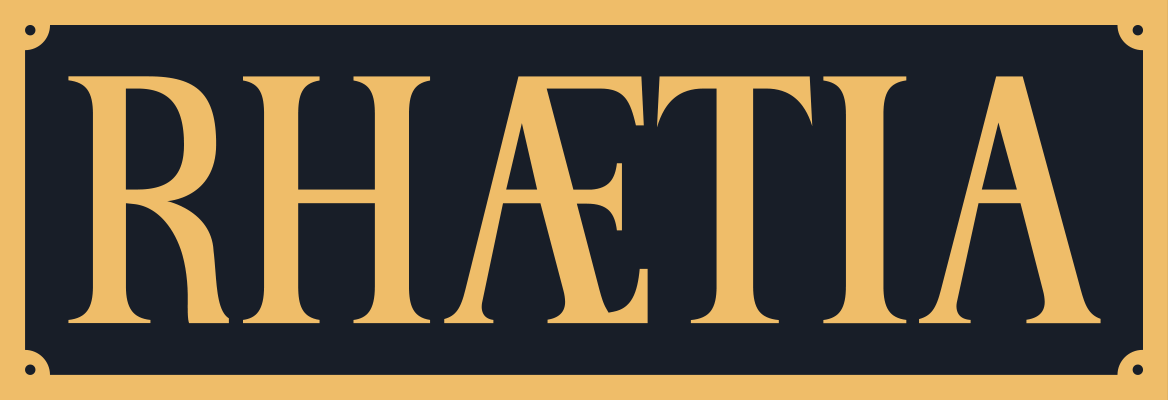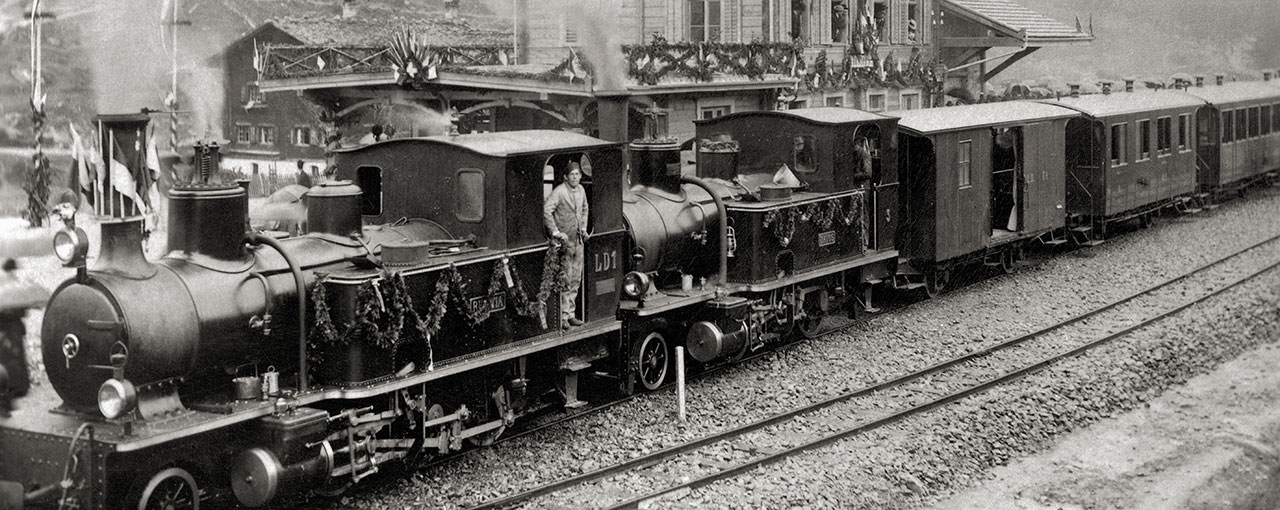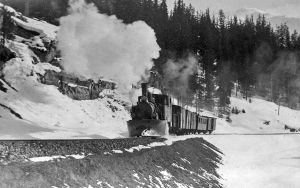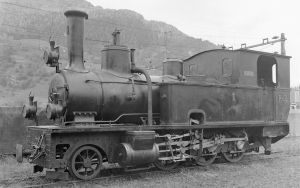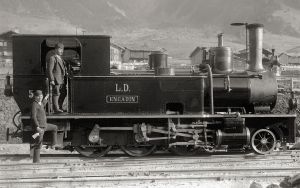The history of our No. 1
RHAETIA has had a long and varied history since she hauled the very first train of the former Landquart-Davos (LD) railway company from Landquart via the Prättigau up to Davos. Built in 1889 and classified as G 3/4 No. 1 (2-6-0 in UK terminology) she has survived, (on occasion only just), to the point where her future is now deservedly secured.
In addition to her technical and industrial history, RHÆTIA also has amassed an immense emotional worth; within the RhB, the canton of Graubünden and of course among a following of railway fans worldwide. RHÆTIA occupies as one would well imagine, a very special position within the impressive historical rolling stock collection of the RhB: she is without doubt, the historical “figurehead”.
RHÆTIA has been out of service since 2014. There are numerous items requiring attention: her boiler needs to be extensively renovated and her copper firebox completely replaced. The brake linkages, the motion, axles and connecting rod bearings all require a complete overhaul. Slide valves and cylinders require grinding and the wheelset is in need of re-tiring.
The Club 1889 has restored, among other things, two historic passenger coaches and a baggage van from the years 1889 and 1897. Thanks now to RHÆTIA, an entire train composition from the founding days of the RhB can now be re-created. This alone adds to the significance of this project; how many railways today are able to present a complete train composition from their opening day?
The Project Group RHÆTIA, comprising of members of the historic RhB clubs, want to bring back the steam engine as far as possible to its original visual state at the time of delivery to LD, so that it can continue to operate as an important historical steam monument of the Rheatian train fleet for railway fans old and young.
The predecessor of the Rhätische Bahn was the metre gauge Landquart – Davos Railway (L-D). It was this company that placed the initial order for 5 saturated-steam 0-6-0 tank locomotives to cover duties on the Landquart – Davos section of the new service. The order for the G3/4 (“Moguls”) went to the Schweizerische Lokomotiv- und Maschinenfabrik in Winterthur (SLM). Numbered 1 to 5 they were named “RHAETIA”, “Prättigau”, “Davos”, “Flüela” and “Engadin”, the names indicating the direction in which the network of the LD would develop. The commissioning of RHAETIA took place on July 8, 1889.
In addition to the motive power of five steam engines, rolling stock comprising of 18 two-axle passenger wagons, three baggage cars and 21 freight wagons was also ordered.
As early as 1893 the locomotive axles and wheels were replaced and in addition RHÆTIA No. 1 received a new fire box in 1894.
In the beginning the locos 1 – 3 were fitted with large snowploughs and at the request of the Spa Davos all locomotives received spark-arrestors after 1899.
It is presumed that in 1895/1896 RHÆTIA received a new inscription from the newly founded RhB and thereby lost her original nameplate.
Upon delivery of more powerful Mallet-locomotives the smaller G3/4 class were relegated to pilot work and light freight duties. The “mountain services” were now in the hands of the more powerful machines. After 1910 the RhB also used the G3/4 for pulling construction trains building the ever-expanding railway network. Following delivery of the G4/5 tender locomotives the G 3/4 went into the reserve pool. Upon completion of electrification and the introduction of more powerful and cost-effective electric traction, RHÆTIA was removed from active service in 1928.
Probably, thinking that it could one day serve as a monument locomotive, the RhB did not scrap RHÆTIA but instead stored it at Landquart. When the “Verein Verkehrshaus der Schweiz” was founded in Zurich in 1942, the RhB loaned No. 1 to the VVS in 1947. The Swiss Museum of Transport was only able to open in 1959, once the city of Lucerne had made land available to the association. As fate would have it, RHÆTIA was not included in the VVS vehicle collection. As a result, RHÆTIA changed location three times: from the tram depot of the Verkehrsbetriebe Zürich in Wiedikon to the Vallorbe depot and the Chexbres-Villages depot. In 1970 the museum railway “Blonay – Chamby” (BC) took over custody and placed it in service. The BC equipped the locomotive with a Friedmann lubricating pump and a turbo generator for electrical lighting. RHÆTIA was then used during the summer seasons from 1980 to 1988, duties included not just the BC route but also on the MOB (Montreux-Oberland-Bahn) and GFM (Chemins de fer Fribourgeois Gruyère – Friborg – Morat) lines.
In preparation for the “100 years jubilee of the RhB” in 1989, the RhB managers decided not to extend the loan agreement with BC and instead repatriate RHÆTIA back to Graubünden. This move required considerable negotiating skills and determination as the BC officials did not want to give up "their" locomotive, which they had pain-stakeingly refurbished.
Up until 2014, RHÆTIA was used for charter excursions and events, much to the delight of rail enthusiasts from far and wide. Particularly noteworthy were the trips on the Bernina route, on the former Misoxerbahn. And, once again at the BC for their 40th anniversary in 2008. RHÆTIA's final duties took place in the RhB anniversary year 2014, “125 years of RhB”. Shortly after she was declared unfit for duty due to her worn out fire box, tubes and suspension. The loco has been carefully stored in the RhB roundhouse depot in Landquart ever since.
-
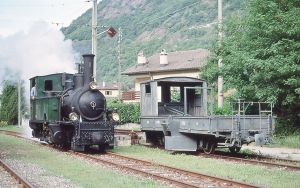 Anlässlich 100 Jahre RhB (1989), machte die RHÆTIA einen Ausflug ins «Valle Mesolcina», hier im Bahnhof Grono
Anlässlich 100 Jahre RhB (1989), machte die RHÆTIA einen Ausflug ins «Valle Mesolcina», hier im Bahnhof Grono -
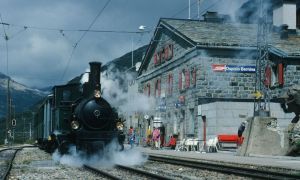 Ein einmaliges Ereignis die Nr.1 in Ospizio Bernina 1995, Foto bei Christian Ticar
Ein einmaliges Ereignis die Nr.1 in Ospizio Bernina 1995, Foto bei Christian Ticar -
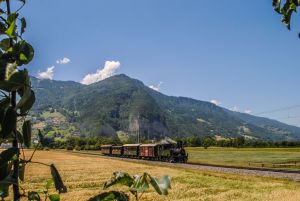 Die letzte Fahrt der RHÆTIA im August 2014
Die letzte Fahrt der RHÆTIA im August 2014 -
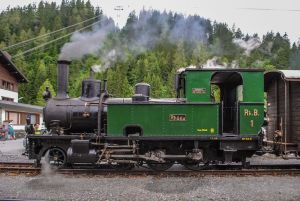 Die RHÆTIA anlässlich ihrer letzen Fahrt 2014
Die RHÆTIA anlässlich ihrer letzen Fahrt 2014 -
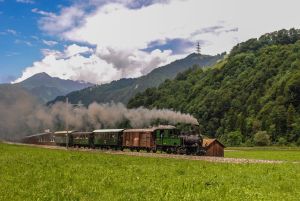 Die letzte Fahrt der RHÆTIA im August 2014
Die letzte Fahrt der RHÆTIA im August 2014 -
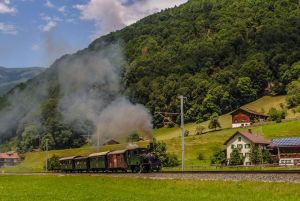 Die RHÆTIA anlässlich ihrer letzen Fahrt 2014
Die RHÆTIA anlässlich ihrer letzen Fahrt 2014 -
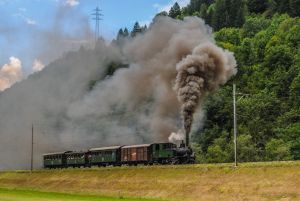 Die RHÆTIA anlässlich ihrer letzen Fahrt 2014
Die RHÆTIA anlässlich ihrer letzen Fahrt 2014
| Technical specifications G 3 / 4 | |
|---|---|
| Class numbering | 1-16 |
| First series (1889) Second series (1893) Third series (1901-1908) |
1-5 6-8 9-16 |
| Manufacturer | SLM (Winterthur) |
| Wheel arrangement | 2-6-0 |
| Design | saturated steam 2 cylinder |
| Type | Tank locomotive |
| Length over the buffers | 7'945mm |
| Empty weight | 23.5t |
| Operating weight | 30.2t |
| Top speed | 45 km/h |
| Continuous output | 184 kW (250 PS) at 20 km/h |
| Tractive effort | 3300kg at 20 km/h |
| Driving wheel diameter | 1'050mm |
| Impeller diameter | 700mm |
| Cylinder diameter | 340mm |
| Piston stroke | 500mm |
| Boiler pressure | 12bar |
| Water supply | 2'600 Liter |
| Fuel supply (coal) | 950kg |
| Operating number | Commissioning | Serial number | Name | Phasing out | Retention |
|---|---|---|---|---|---|
| 1 | 08.07.1889 | 577 | RHÆTIA | 1928 | 1 1928-1970 various locations in Switzerland (parked) 1970 Blonay-Chamby (operative condition) as from 1988 back at RhB (operative condition) since 2014 (out of operation) |
| 2 | 05.08.1889 | 578 | PRAETTIGAU | 1925 | scrapped |
| 3 | 16.08.1889 | 579 | DAVOS | 1917 | Prinz-Heinrich-Bahn (No. S3), 1943 DR 99 271, 1945 CFL 351, scrapped 1954 |
| 4 | 10.10.1889 | 580 | FLUELA | 1917 | Prinz-Heinrich-Bahn (No. S5), 1943 DR 99 272, 1945 CFL 352, scrapped 1954 |
| 5 | 13.10.1889 | 581 | ENGADIN | 1917 | Prinz-Heinrich-Bahn (No. S6), 1943 DR 99 273, 1945 CFL 353, scrapped 1954 |
| 6 | 05.03.1896 | 960 | LANDQUART | 1923 | 1923 sold to Administracao Portuaria do Recife (harbour authority of Recife, Pernambuco State) in Brazil; missing |
| 7 | 19.03.1896 | 961 | CHUR | 1923 | 1923 to Centovalli railway company, scrapped 1943 |
| 8 | 01.04.1896 | 962 | THUSIS | 1923 | 1923 to Centovalli railway company, scrapped 1943 |
| 9 | 10.06.1901 | 1369 | - | 1926 | 1926 to Brünigbahn (SBB No. 127) scrapped 1941 |
| 10 | 25.06.1901 | 1370 | - | 1926 | 1926 to Brünigbahn (SBB No. 128) scrapped 1941 |
| 11 | 08.01.1903 | 1476 | - (later Heidi) | 1977 | 1977 to Modelrailfriends Eiger, 1999 to Club 1889, since 2015 back in operation at Samedan (RhB) |
| 12 | 23.01.1903 | 1477 | - | 1923 | 1923 to Steelworks Sagunt, Spain (No. 207 “Algimia”), scrapped around 1970 |
| 13 | 06.02.1903 | 1478 | - | 1950 | scrapped 1950 |
| 14 | 06.02.1903 | 1479 | - (later Madlaina) | 1972 | 1972 to Steamloki association Appenzeller Railway (operative condition) |
| 15 | 31.07.1908 | 1910 | - | 1924 | 1924 to Brünigbahn (SBB No. 215), scrapped 1942 |
| 16 | 31.07.1908 | 1911 | - | 1924 | 1924 to Brünigbahn (SBB No. 216), scrapped 1942 |
RHÆTIA’s historical significance
From the perspective of the preservation of historical monuments the locomotive’s importance is explained in a short documentation “Significance of Preservation and Assessment of historic vehicles of RhB”. This documentation was compiled on behalf of the ‘Care of Bündner Monuments’ in 2008 by Hans-Peter Bärtschi of ARIAS Industriekultur, Winterthur, with the aim of prioritising the investments of ‘Monument Care’. The following aspects are of interest in RHÆTIA’s case:
– RHÆTIA is of national importance being one of the oldest Swiss locomotives and “founder locomotive” of the Rhätische Bahn.
– RHÆTIA represents the popular first generation 2-6-0 coupled tank locomotive design.
– RHÆTIA exists today in almost original condition.
– RHÆTIA is witness to the very early efforts to preserve a historical railway vehicle in Switzerland.
More information regarding RHAETIA including other historical rolling stock of RhB are to be found here.
